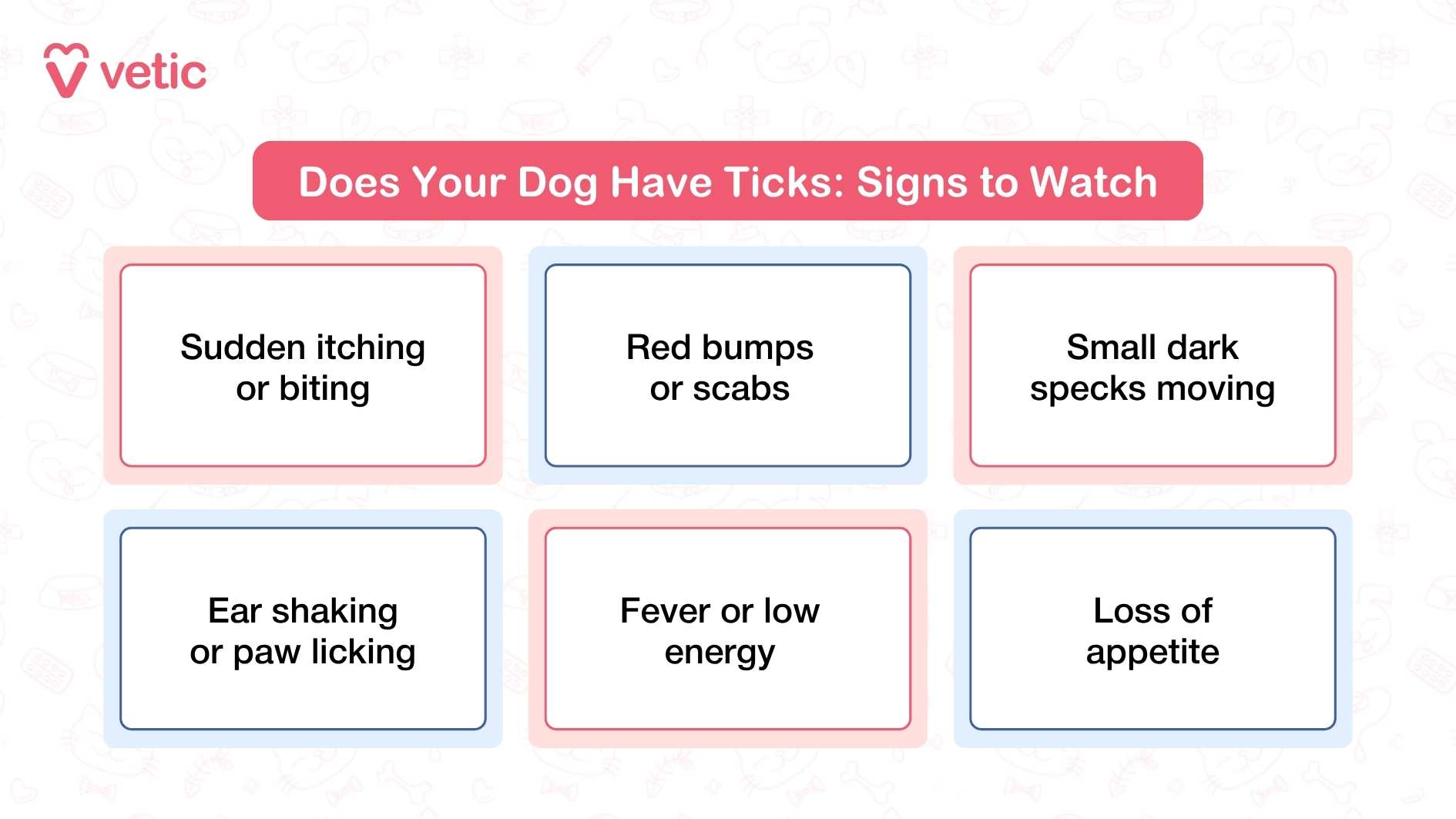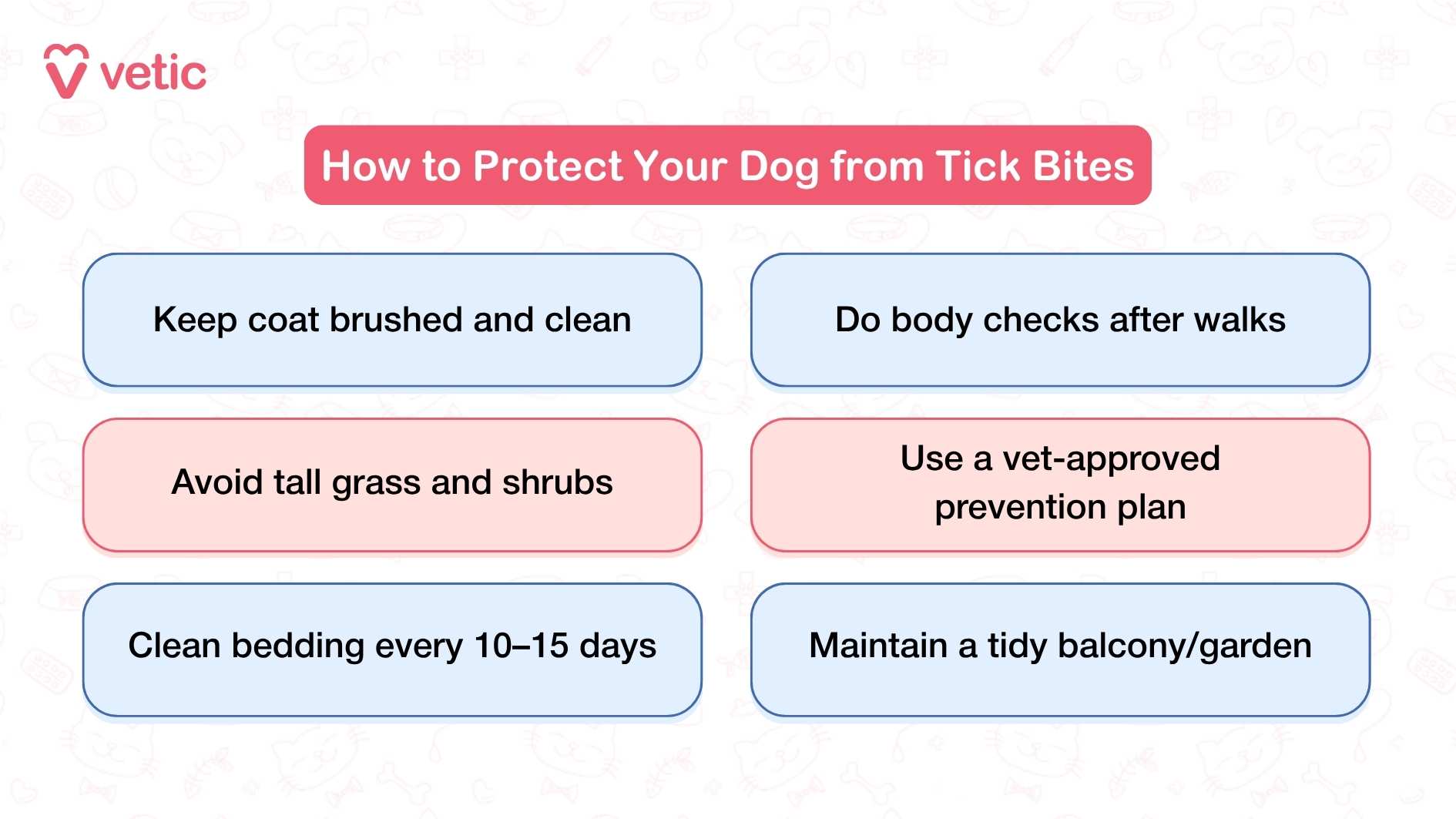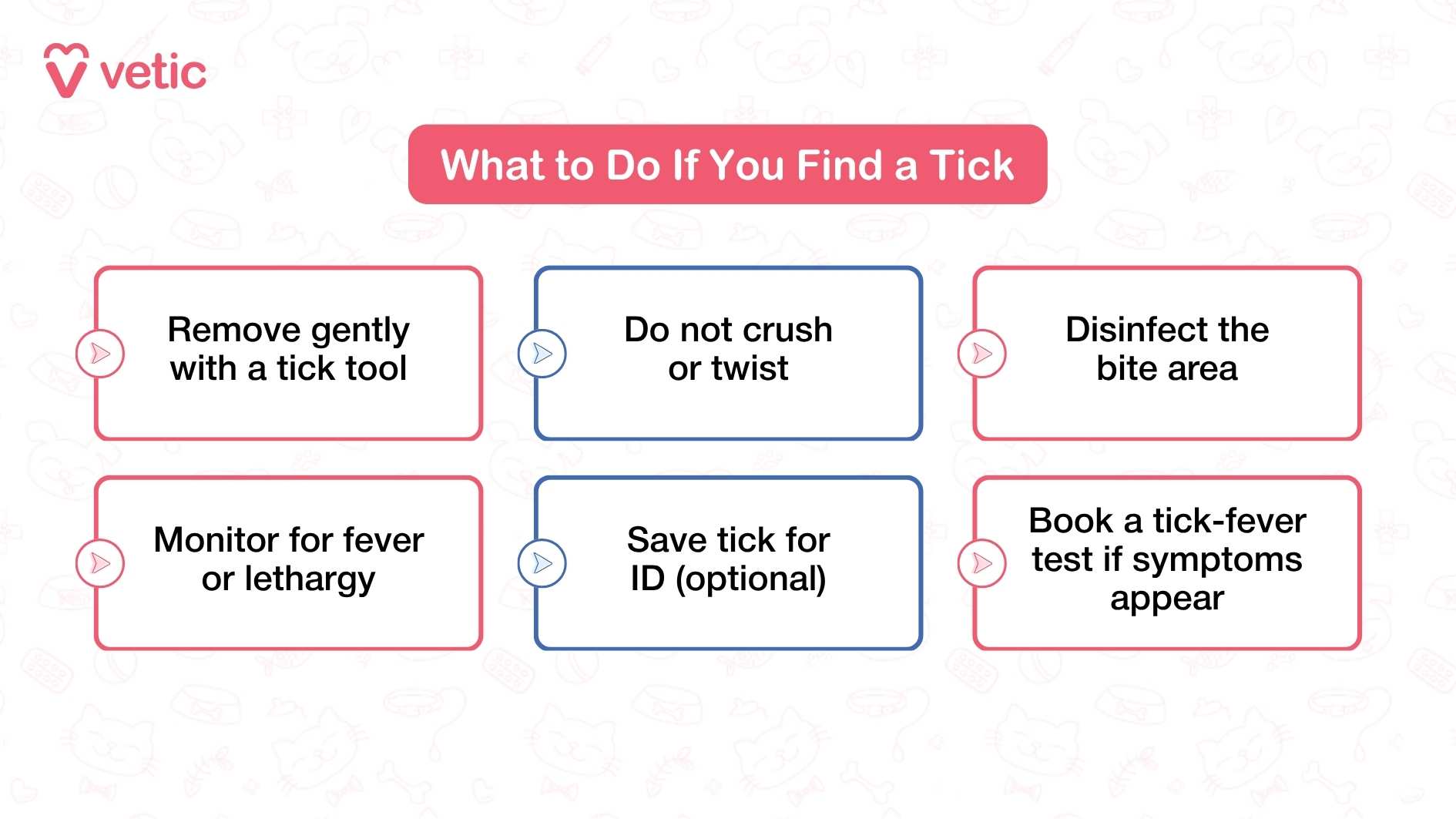Ticks are an unavoidable part of life in India’s warm, humid climate. They thrive in parks, gardens, fields, and even small patches of grass outside apartment buildings. Because ticks can latch onto any passing animal and transmit dangerous infections like ehrlichiosis and babesiosis, consistent tick prevention is one of the most important steps in keeping your dog safe and healthy.
Despite what many pet parents believe, tick prevention isn’t about avoiding one particular place or switching shampoos frequently. It’s about understanding the risks, choosing the right products, and using them correctly throughout the year.

Does Your Dog Have Ticks? How Can You Tell?
Ticks are small, fast, and excellent at hiding. Many dog parents only notice them when the infestation grows, which is why early signs matter.

Your dog may not always scratch excessively, but you might notice subtle changes: a red bump, a small scab, or a tiny dark speck moving through the fur. Ticks often hide in warm, protected spots such as behind the ears, between the toes, under the collar, or at the base of the tail.
If you’re unsure whether it’s dirt, a scab, or a tick, a groomer or vet can identify it quickly.
Which Dogs Are More at Risk of Tick Infestations?
Some lifestyles naturally expose dogs to more ticks. Dogs who spend time outdoors, socialize with other dogs, play in parks, or live near farms or gardens tend to attract ticks more frequently. Long-haired and double-coated breeds also make it easier for ticks to hide.
City dogs are just as vulnerable. Ticks survive remarkably well in urban greenery and shared pet areas, so even short walks can be enough to bring them home.

How to Protect Your Dog From Tick Bites
True tick prevention is layered protection, not a single product once a month. A realistic prevention plan includes the right repellent, the right frequency, and the right hygiene practices at home.
Some habits go a long way, such as routine grooming, doing a quick body check after walks, and keeping your dog’s living space clean. A consistent approach is far more effective than switching between products only after spotting ticks.
Protection From Ticks: What Options Are Available in the Market?
There are multiple tick-prevention tools available today. Each one works differently, and most dogs need a combination depending on their environment, breed, and activity level.

- Tick collars
- Oral tick preventives
- Spot-on medications
- Tick repellent sprays
- Tick shampoos
- Environmental/home repellents
Understanding how each option works will help you choose the safest and most effective plan.
Tick Collars for Protection
Tick collars are one of the most reliable long-term preventives because they release medication slowly across your dog’s skin over weeks or months. When fitted correctly and chosen according to your dog’s body weight, they offer continuous protection.
However, collars must be used carefully. They should be vet-recommended, checked regularly for signs of irritation, and removed during baths if they’re not waterproof. A dog should never chew or lick the collar, and you must replace it as per the brand’s schedule.
Oral Medication for Protection From Ticks
Oral medicines are prescription-strength preventives that work from inside the bloodstream. They kill ticks once they bite, making them extremely effective for dogs with recurrent infestations or those who cannot tolerate topical solutions.
These medicines, however, are not suitable for every dog. Certain breeds with the MDR-1 gene mutation or dogs with existing medical issues may need alternative options. This is why oral medications should only be given after a vet’s evaluation.
Spot-on Solutions for Protection From Ticks
Spot-ons are applied at the base of the neck and distribute protection along the coat. They are easy to use and widely available but often misunderstood. Most spot-ons kill ticks after they bite; meaning they don’t always prevent the initial bite itself. However, the reduce the duration of the latching – meaning, spot-ons can reduce the chances of the transmission of the disease causing microbes from the ticks.
So, which spot-on repels ticks?
Only a few veterinary-strength spot-ons offer true repellency. Your veterinarian can guide you toward brands that repel ticks before they attach, depending on your dog’s exposure level.
Do Dog Tick Protection Sprays and Powders Repel Ticks?
Tick sprays work well as immediate, short-term protection. They are especially helpful before and after activities like park visits or outdoor play. Sprays can repel ticks on contact and are useful on areas, such as paws and legs.
However, sprays wear off quickly, and powders are less common today because of inhalation risks. They should always be used sparingly and only according to instructions.
Do Tick Shampoos Provide Protection From Ticks?
Tick shampoos help remove ticks during a bath but do not provide lasting protection. They are supportive, not preventive, and work best alongside a collar, oral medication, or spot-on — not as a replacement for them.

What Should You Do If You See a Tick on Your Dog?
If you find a tick, remove it gently using tweezers or a tick-removal tool. Avoid crushing, twisting, or applying oil, as this can cause the tick to release more bacteria into your dog’s skin. Clean the area and monitor your pet closely for fever, lethargy, pale gums, or appetite changes.
Even one tick bite warrants a consultation, especially if your dog seems off in the days following.
Should You Get Your Dog Tested for Tick Fever?
Testing is recommended if your dog has had visible ticks, shows signs of illness, or has been lethargic, feverish, or uninterested in food. A basic blood test is often enough to catch tick fever early, when treatment is simpler and outcomes are better.
Choosing a Flea and Tick Combination Medicine for Dogs
Your veterinarian will consider several factors before selecting the right preventive plan:
1. Application Method
Topical, oral, or collar-based depending on what your dog tolerates best.
2. Geographic & Seasonal Risks
Some regions have higher tick pressure than others.
3. Exposure Level
Dogs who visit parks, farms, or daycare need stronger layers of protection.
4. MDR-1 Gene Factors
Certain breeds cannot safely take some medications, such as ivermectin.
5. Lifestyle and Activity Level
Swimming, trekking, and outdoor play influence how long medications last.
6. Life Stage
Puppies, seniors, and pregnant dogs may need specific formulations.
7. Medical Conditions
Skin diseases, liver conditions, or allergies can change which product is safe.
Over-the-Counter vs. Prescription Flea and Tick Medicine
Not all flea and tick medicines are created equal.
Over-the-counter flea repellents
These include powders, collars, shampoos, and certain spot-ons. They’re easy to purchase but vary widely in strength and efficacy. They should only be used after consulting a vet.
Prescription medications for fleas
These are clinically tested and regulated, offering stronger and more consistent protection. Your vet will recommend them based on your dog’s health and routine.
Seasonal Tick Prevention Tips
Ticks peak in warm, humid months — especially during monsoon season. During these periods, prevention needs to be more frequent and more vigilant.
A few seasonal habits that help:
- Increase grooming and brushing
- Use tick sprays before outdoor activities
- Wash bedding more frequently
- Vacuum carpets and sofas
- Avoid tall grass and densely planted areas
- Review your dog’s preventive plan with your vet
Conclusion
Ticks are everywhere, but you can absolutely keep your dog safe with the right prevention strategy, consistent habits, and timely vet guidance. Tick protection isn’t about a single product — it’s about finding the combination that fits your dog’s unique routine.
With consistent prevention, you can keep your dog tick-free and safe from tick-borne illnesses. Book a Vetic tick-prevention consult today.
FAQs
1. Why is my dog getting ticks even after using tick products?
Ticks are widespread in India, and no product offers 100% prevention. Using layered protection reduces risk, but tick prevention in dogs must be consistent and year-round.
2. What is the safest tick prevention method for dogs?
The safest approach is a combination of a tick collar, spot-on or oral preventive, and regular grooming. This layered routine offers the most effective tick prevention for dogs.
3. Can tick shampoos alone protect my dog from tick bites?
No. Tick shampoos only remove surface ticks. They don’t provide lasting tick prevention in dogs, so they must be paired with collars, sprays, or spot-ons.
4. How often should I apply tick spray to protect my dog?
Tick sprays offer short-term protection and may need application before and after outdoor activity. Use them alongside long-term tick prevention methods for best results.
5. Are oral tick medications safe for all dogs?
Oral tick preventives are effective for tick prevention in dogs, but some breeds with the MDR-1 gene cannot take them. Always check with your veterinarian before use.
6. When should I worry about tick fever in my dog?
If your dog shows fever, lethargy, pale gums, or appetite loss after a tick bite, contact your vet. Early testing ensures timely treatment for tick-borne illnesses.
7. Can indoor dogs still get ticks?
Yes. Ticks can enter homes through clothes, shoes, balconies, or other pets. Indoor dogs still need effective tick prevention to stay protected.

